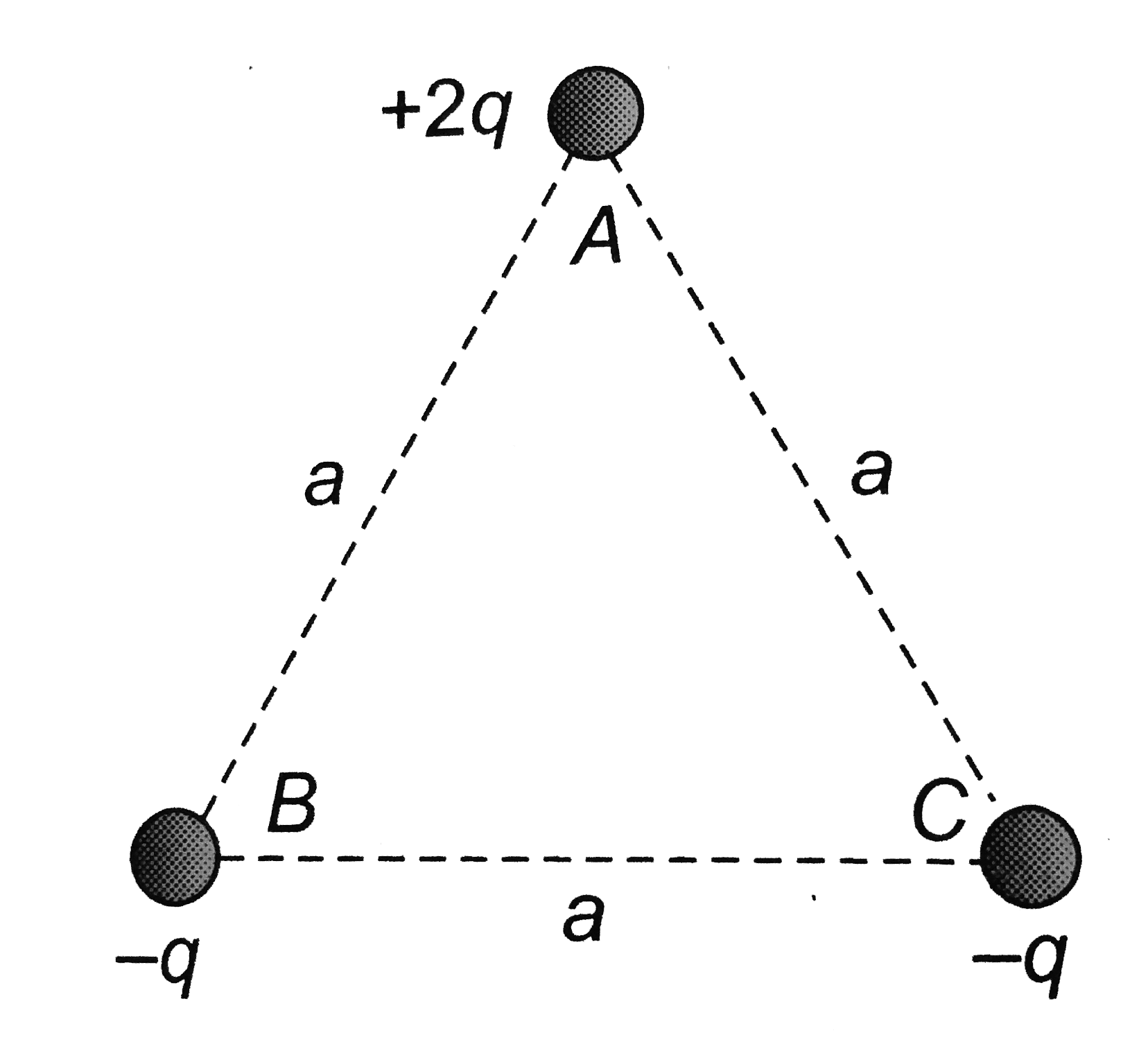Four charges are placed, respectively, at the corners of a square of side , arranged in the given order. are the midpoints of sides , respectively, is the center of square.
The work done in carrying a charge from to is.
zero
The correct Answer is:B
To solve the problem of calculating the work done in carrying a charge e from point O (the center of the square) to point F (the midpoint of side CD), we will follow these steps:
Step 1: Understand the Configuration
We have four charges placed at the corners of a square:
- Charge +q at point A
- Charge +q at point B
- Charge −q at point C
- Charge −q at point D
The square has a side length of a. Points E and F are the midpoints of sides BC and CD, respectively, and point O is the center of the square.
Step 2: Calculate the Potential at Point F
The potential VF at point F is the sum of the potentials due to all four charges:
VF=VA+VB+VC+VD
Where:
- VA=14πϵ0qrAF
- VB=14πϵ0qrBF
- VC=14πϵ0−qrCF
- VD=14πϵ0−qrDF
Step 3: Calculate Distances
To find the distances rAF,rBF,rCF, and rDF:
- The distance from A to F and from B to F can be calculated using the Pythagorean theorem. Since F is the midpoint of CD, the coordinates of F are (a2,a) and those of A and B are (0,a) and (a,a) respectively.
- Thus, rAF=rBF=√(a2)2+(0)2=a√2.
- The distances rCF and rDF are a2.
Step 4: Substitute Distances into Potential Formula
Now substituting the distances into the potential equations:
VF=14πϵ0⎛⎜⎝qa√2+qa√2−qa2−qa2⎞⎟⎠
This simplifies to:
VF=14πϵ0(2q√2a−2qa)=q4πϵ0a(2√2−2)
VF=q(√2−1)2πϵ0a
Step 5: Calculate the Potential at Point O
The potential at the center O of the square is zero since the contributions from the positive and negative charges cancel each other out:
VO=0
Step 6: Calculate Work Done
The work done W in moving the charge e from O to F is given by:
W=e(VF−VO)=eVF
Substituting VF:
W=e⋅q(√2−1)2πϵ0a
Final Answer
Thus, the work done in carrying the charge e from O to F is:
W=eq(√2−1)2πϵ0a
We have four charges placed at the corners of a square:
- Charge +q at point A
- Charge +q at point B
- Charge −q at point C
- Charge −q at point D
The potential VF at point F is the sum of the potentials due to all four charges:
VF=VA+VB+VC+VD
Where:
- VA=14πϵ0qrAF
- VB=14πϵ0qrBF
- VC=14πϵ0−qrCF
- VD=14πϵ0−qrDF
To find the distances rAF,rBF,rCF, and rDF:
- The distance from A to F and from B to F can be calculated using the Pythagorean theorem. Since F is the midpoint of CD, the coordinates of F are (a2,a) and those of A and B are (0,a) and (a,a) respectively.
- Thus, rAF=rBF=√(a2)2+(0)2=a√2.
- The distances rCF and rDF are a2.
Now substituting the distances into the potential equations:
VF=14πϵ0⎛⎜⎝qa√2+qa√2−qa2−qa2⎞⎟⎠
This simplifies to:
VF=14πϵ0(2q√2a−2qa)=q4πϵ0a(2√2−2)
VF=q(√2−1)2πϵ0a
The potential at the center O of the square is zero since the contributions from the positive and negative charges cancel each other out:
VO=0
The work done W in moving the charge e from O to F is given by:
W=e(VF−VO)=eVF
Substituting VF:
W=e⋅q(√2−1)2πϵ0a
Thus, the work done in carrying the charge e from O to F is:
W=eq(√2−1)2πϵ0a
Topper's Solved these Questions
- ELECTRIC POTENTIALBOOK - CENGAGE PHYSICS ENGLISHCHAPTER - ELECTRIC POTENTIALEXERCISE - Integer
5 Videos
- ELECTRIC POTENTIALBOOK - CENGAGE PHYSICS ENGLISHCHAPTER - ELECTRIC POTENTIALEXERCISE - DPP 3.1
14 Videos
- ELECTRIC POTENTIALBOOK - CENGAGE PHYSICS ENGLISHCHAPTER - ELECTRIC POTENTIALEXERCISE - Multiple Correct
10 Videos
- ELECTRIC FLUX AND GAUSS LAWBOOK - CENGAGE PHYSICS ENGLISHCHAPTER - ELECTRIC FLUX AND GAUSS LAWEXERCISE - MCQ s
38 Videos
- ELECTRICAL MEASURING INSTRUMENTSBOOK - CENGAGE PHYSICS ENGLISHCHAPTER - ELECTRICAL MEASURING INSTRUMENTSEXERCISE - M.C.Q
2 Videos
Similar Questions
Four charges +q,+q,−q,and−q are placed, respectively, at the corners A,B,C,andD of a square of side a, arranged in the given order. EandF are the midpoints of sides BCandCD, respectively, O is the center of square.
The electric potential at O is.
View SolutionFour charges +q,+q,−q,and−q are placed, respectively, at the corners A,B,C,andD of a square of side a, arranged in the given order. If O is the center of square.
The electric field at O is.
View SolutionFour charges of +q, +q +q and +q are placed at the corners A, B, C and D of s square. The resultant force on the charge at D
View SolutionFour charges of +q, +q +q and +q are placed at the corners A, B, C and D of s square. The resultant force on the charge at D
View SolutionCharges q,2q,3q and 4q are placed at the corners A,B,C and D of a square as shown in the following figure. The directon of electric field at the centre of the square is along

View SolutionCharges q,2q,3q and 4q are placed at the corners A,B,C and D of a square as shown in the following figure. The directon of electric field at the centre of the square is along

View SolutionThree charges of (+2q),(−q) and (−q) are placed at the corners A,B and C of an equilateral triangle of side a as shown in the adjoining figure. Then the dipole moment of this combination is

View SolutionFour point charges are respectively placed at the corners A, B, C and D of a square of side a. If F is the mid-point of side CD, the work done in carrying an electron of charge from O [the centre of the square] to F fill be:
View SolutionEqual charges Q are placed at the four corners A, B, C, D of a square of length a. The magnitude of the force on the charge at B will be
View SolutionFour charges +q,−q,+q and −q are placed in order on the four consecutive corners of a square of side a. The work done in interchanging the positions of any two neighboring charges of the opposite sign is
View Solution
